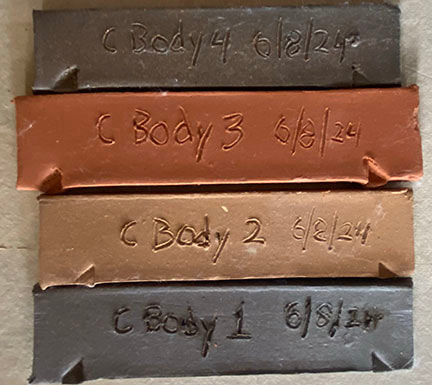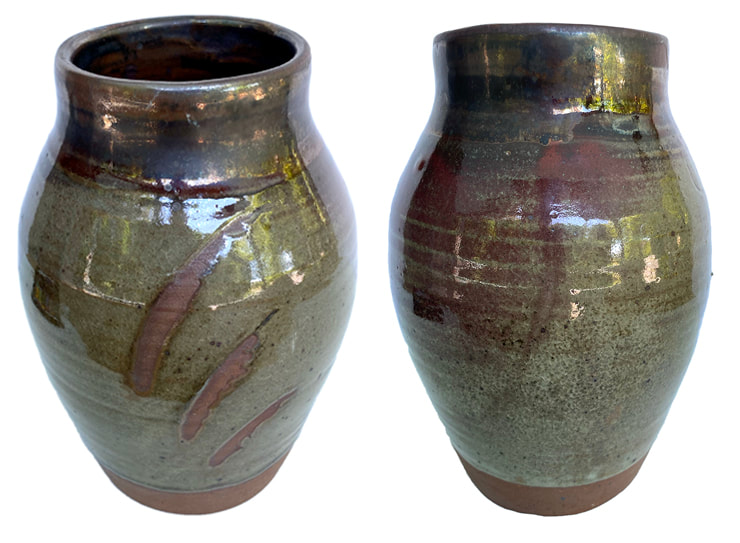NCC East 40 Wild Clay
About this page
This page is about formulating usable clay bodies and glazes from clay dug right from the campus of Northampton Community College (NCC).
My History with the East 40 Wild Clay
NCC has 40 acres on the Eastern edge of their campus that is aptly called the NCC East 40 www.ncceast40.org where among a lot of other things, clay is dug and processed. Walter Heath and his students were the first to begin harvesting and processing this clay, but sadly there isn't much in the way of records as to what they did. I first used the East 40 clay in my maters thesis exhibition work, and in 2022 made up two clay bodies to for use in the wood kilns at the East 40. I like seeing what local materials can do in glazes, and since I had access to the East 40 clay I had included it in some of the glaze explorations I had made from 2022-2024. Beginning in the summer of 2024 I was actually asked to develop clay bodies and glazes from this wild clay, thus the blog post mentioned above and why I'm starting this section with information specific to the NCC East 40 clay and glazes. The hope is I will get around to adding information not just about the other local materials I've worked with, but techniques and tips etc. that would be of interest to ceramic students and artists.
This page is about formulating usable clay bodies and glazes from clay dug right from the campus of Northampton Community College (NCC).
My History with the East 40 Wild Clay
NCC has 40 acres on the Eastern edge of their campus that is aptly called the NCC East 40 www.ncceast40.org where among a lot of other things, clay is dug and processed. Walter Heath and his students were the first to begin harvesting and processing this clay, but sadly there isn't much in the way of records as to what they did. I first used the East 40 clay in my maters thesis exhibition work, and in 2022 made up two clay bodies to for use in the wood kilns at the East 40. I like seeing what local materials can do in glazes, and since I had access to the East 40 clay I had included it in some of the glaze explorations I had made from 2022-2024. Beginning in the summer of 2024 I was actually asked to develop clay bodies and glazes from this wild clay, thus the blog post mentioned above and why I'm starting this section with information specific to the NCC East 40 clay and glazes. The hope is I will get around to adding information not just about the other local materials I've worked with, but techniques and tips etc. that would be of interest to ceramic students and artists.
Clay Body C
Not a very romantic name, but "C" what we're going with for now. I mixed up a many batches of Bodies A and B in 2022. These recipes (from Walter Heath) were the first two Cone 10 (high fire) clay bodies made with the East 40 clay, and were used in a number of wood kiln firings at the East 40. I worked with both bodies personally as did my students and others, so I got to see how both bodies behaved (or didn't) in actual wood kiln firings. the East 40 clay on it's own melts at too low a temperature and is too "short" (stiff, not plastic) to use by its self, which is why a clay body-essentially a recipe-has to be used, and not just 100% of the East 40 Wild Clay. In the summer of 2024 I came up with "Clay Body C" based on my experiences with the first two bodies, and testing so far seems extremely promising. I like clays and glazes with as few ingredients as possible; it's easier to tinker if something goes wrong if there are fewer parts, and it just satisfies my sensibilities. A three ingredient clay body seems to me more elegant than one chock-full-of ingredients. Here is the basic recipe:
- 1 part East 40 Wild Clay
- 1 part Hawthorn Fire Clay
- 1 part OM4 Ball Clay
The numbers of the tiles were scratched into the clay when it was wet; 4 is on top, down to 1 at the bottom. Tiles 1 & 4 were fired to cone 10 in reduction, which is how we fire the wood kiln at the East 40. 3 was only bisque fired to cone 05, and 2 was fired to cone 6, both of them in oxidation in an electric kiln.
C Body Testing Results
I've already made several small batches of test bars of the C body clay, and put them through a number of "paces." I also did some test bars of pure East 40 wild clay for comparison, you can see a photo of some of these bars in the header. I kept one tile that was only bisque fired in an electric kiln, and one that was only bisque fired in the gas test kiln. Bisque ware isn't a finished product, but it's nice to have samples of what the body looks like in a bisque state. The more important variables tested were the differences between cone 6 and cone 10, between oxidation and reduction, and between high fire after bisque and single fire, where greenware is brought up to high fire without first being bisqued. I have a whole worksheet that I fill out for each batch of test bars. These sheets in all honestly provide more information than is really necessary, so I'm going to give you the most important statistics here, and then a bit of explanation about the practical implications of those statistics.
Absorption:
Cone 10-1.02%
Cone 6-1.04%
Shrinkage from wet to High Fire:
Cone 10-14%
Cone 6-13.3%
Absorption is a great way of measuring if the clay is vitrified. You don't want stoneware to have an absorption of more than 3%, so getting so close to 1% is frankly a very exciting result! The East 40 wild clay (as opposed to the Clay body recipe C) is low fire, and so acts as a kind of flux in the clay recipe. The real shocker for me was the low absorption rate at cone 6! 1.04% would be fine for cone 10, and in fact plenty of commercially manufactured clay bodies at both temperatures have higher (less desirable) absorption rates than that. Testing shows that clay body C stuck a home run with this test.
Shrinkage happens in a number of stages. First, some people (like me) add more water/work with clay wetter than others. The more water you add to the clay, the more evaporates and so the higher your shrinkage. 12-14% is the average range of shrinkage, and the body C clay stayed within this range, although at the upper end.
The next steps in testing clay body C is going to simply repeating some of the testing to make sure that these results hold up with repetition, and seeing what happens with the addition of grog. I just made a batch of body C where 20% of the East 40 wild clay is in grog form, the other 80% in the wet plastic form. (Grog is clay that has been bisque fired. The grog I used is essentially a powder, unlike some grogs that are like little chips) Ultimately the recipe is the same, since when fired the plastic clay and the grog will become chemically exactly the same. But, since there is a lot of shrinkage between wet clay and bisque fired, the addition of the grog should reduce the shrinkage of the clay. And, it may (or may not) provide some beneficial properties to the handling of the clay. If the clay doesn't handle as well with the addition of grog, 14% shrinkage is still within a respectable range, so if the grog doesn't help, no problem, but if could be helpful so definitely worth a try.
Absorption:
Cone 10-1.02%
Cone 6-1.04%
Shrinkage from wet to High Fire:
Cone 10-14%
Cone 6-13.3%
Absorption is a great way of measuring if the clay is vitrified. You don't want stoneware to have an absorption of more than 3%, so getting so close to 1% is frankly a very exciting result! The East 40 wild clay (as opposed to the Clay body recipe C) is low fire, and so acts as a kind of flux in the clay recipe. The real shocker for me was the low absorption rate at cone 6! 1.04% would be fine for cone 10, and in fact plenty of commercially manufactured clay bodies at both temperatures have higher (less desirable) absorption rates than that. Testing shows that clay body C stuck a home run with this test.
Shrinkage happens in a number of stages. First, some people (like me) add more water/work with clay wetter than others. The more water you add to the clay, the more evaporates and so the higher your shrinkage. 12-14% is the average range of shrinkage, and the body C clay stayed within this range, although at the upper end.
The next steps in testing clay body C is going to simply repeating some of the testing to make sure that these results hold up with repetition, and seeing what happens with the addition of grog. I just made a batch of body C where 20% of the East 40 wild clay is in grog form, the other 80% in the wet plastic form. (Grog is clay that has been bisque fired. The grog I used is essentially a powder, unlike some grogs that are like little chips) Ultimately the recipe is the same, since when fired the plastic clay and the grog will become chemically exactly the same. But, since there is a lot of shrinkage between wet clay and bisque fired, the addition of the grog should reduce the shrinkage of the clay. And, it may (or may not) provide some beneficial properties to the handling of the clay. If the clay doesn't handle as well with the addition of grog, 14% shrinkage is still within a respectable range, so if the grog doesn't help, no problem, but if could be helpful so definitely worth a try.

